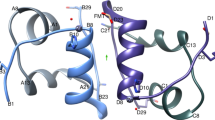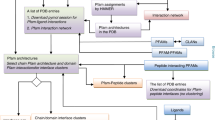Abstract
THE molecule of insulin consists of polypeptide chains of two kinds linked together by cystine residues. The complete amino sequence in these chains is now known, thanks to the work of Sanger and his co-workers1. The A chains of Sanger's acid fraction contain twenty-one residues and the B chain thirty residues. There are four half-cystine residues in the A chains and two in each of the B chains, and their positions in the residue sequence are A6, A7, All, A20 and B7, B19. The minimum molecular weight has generally been reported to be about 12,000; but recently a value of the order of 6,000 has also been put forward. If the former value is correct, there will be two A and two B chains in the molecule, while there can only be one of each if the latter value is confirmed. It follows that if the linking arrangement could be determined, the complete chemical structure of this protein molecule would be known. There are many conceivable ways of linking the chains together and in the case of four chains there are some hundreds. It would be a considerable advance towards determining the complete structure if all those which are sterically impossible could be eliminated.
This is a preview of subscription content, access via your institution
Access options
Subscribe to this journal
Receive 51 print issues and online access
$199.00 per year
only $3.90 per issue
Buy this article
- Purchase on Springer Link
- Instant access to full article PDF
Prices may be subject to local taxes which are calculated during checkout
Similar content being viewed by others
References
Sanger, F., and Tuppy, H., Biochem. J., 49, 463 (1951). Sanger, F., and Thompson, E. O. P., Biochem. J., 53, 366 (1953).
Pauling, L., Corey, R. B., and Branson, H. R., Proc. U.S. Nat. Acad. Sci., 37, 205 (1951). Pauling, L., and Corey, R. B., Proc. U.S. Nat. Acad. Sci., 37, 235 (1951).
Hartley, G. S., and Robinson, C., Trans. Farad. Soc., 48, 847 (1952). Robinson, C., and Ambrose, E. J., Trans. Farad. Soc., 48, 854 (1952).
Low, B. W., Nature, 169, 955 (1952).
Rothen, A., Chow, B. F., Greep, R. O., and van Dyke, H. B., Cold Spring Harbor Symp. Quant. Biol., 9, 272 (1941).
Kuhn, W., Z. Elektrochem., 56, 506 (1952).
Riley, D. P., and Arndt, U. W., Nature, 171, 144 (1953).
Elliott, A., Ambrose, E. J., and Robinson, C., Nature, 166, 194 (1950).
Author information
Authors and Affiliations
Rights and permissions
About this article
Cite this article
ROBINSON, C. Structure of Insulin as indicated by Atomic Models. Nature 172, 27–28 (1953). https://doi.org/10.1038/172027a0
Issue Date:
DOI: https://doi.org/10.1038/172027a0
This article is cited by
-
Experimental Data and Model Structures for the Insulin Molecule
Nature (1953)
-
Structure of Insulin
Nature (1953)
-
Intra-Helix S—S Linked Structures for Insulin
Nature (1953)
Comments
By submitting a comment you agree to abide by our Terms and Community Guidelines. If you find something abusive or that does not comply with our terms or guidelines please flag it as inappropriate.



